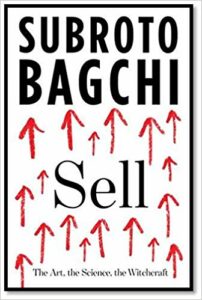Sell, by Subroto Bagchi, the co-founder of Mindtree, is an interesting take on what comprises the process of selling.

Be it Professionals, Entrepreneurs or Employees, we are constantly in the pursuit of selling our products/services or beliefs. Below is my interpretation of the book –
- Irrespective of what people are selling and what type of doors they may be knocking at, the basics of selling remain the same
- Selling is a 3 legged stool – all in equal measure
- part ART (being confident in the moment)
- part SCIENCE (machine learning & personalisation of you web pages has upped the expectations from real sales people)
- part WITCHCRAFT (the craft of keeping people hooked)
- Most sales people will resonate with the term “Sales Funnel” & “Prospecting”. The idea is to keep your funnel wide open while prospecting. Take this for perspective: the Coho salmon fish typically reproduces 2500 eggs. Out of this, only 375 hatch. Only 30 survive out of the 375 and only 5 make it to the ocean (0.2% success rate). Same can be the cycle from Prospecting to Closing.
- Not all prospects must be given equal importance. Prospects to be wary of –
- the great giver of homework – Someone who with purely technical expertise & no business call
- patron saint of thought leadership (almost CXO) – Someone who almost lost on the final promotion & has only his vision/thoughts to give to you
- the permanent prospect – they never really proceed beyond the ideation
- the poor Brahmin – Someone who loves the idea but has no money
- Maintain your GQ – Google Quotient. Earlier only the seller had info, now the buyer has as much and more.
- Always keep the Physics (form and the product), Chemistry (between people) and Maths (profit to both parties) in your mind
- An org chart is as important to the external world as it is within the organisation. Type of people you must always be aware before and after the deal –
- Vendor selection expert (To get you in the initial list)
- Buyer (To get the expectation on product & price right)
- External expert (Which ‘consultancy’ is helping the org?)
- Influencer (The internal informal project counsel)
- Detractor (Someone who is not very fond of the idea/leader)
- Coach (The official mentor of the buyer)
- Competition (Your competition of course)
- Lawyer (legal team – they may be slow, but they hell can put you to a dead end)
- Sponsor (whose idea brought the deal in the first place)
- Starbucks and McDonald’s don’t sell just coffee or burger. They sell much more than that. Stories and Standardisation
- Never go to play with a single pitch or a single story. Always have at least 5 Offensive and 3 Defensive plays on your product. Here’s where marketing can help in designing these plays
- Marketing has also been shifting from the War room to the Battlefield. Earlier people used to carpet bomb everyone with everything. Now, it’s a personalised laser guided strike
- Forcing the client to follow your thought process rather than speaking in alignment of theirs doesn’t send out a good message – It is good to have a narrative in place for the presentation but only after you’ve really understood what the client wants
- Whenever you refer to something in a proposal, like data, opinions, points of view of even clients site graphics, which you actually learnt from somewhere else, you are obliged to acknowledge its source – Legal Alert!
- You need to persuade rather than convince. Persuasion begins with selling, it requires to –
- respect other person
- suspending judgement
- enquiry
- begins with recognising emotional needs of people
- requires advisory ability and works best when you hold up a larger purpose in front of the customer
- More often than not we give wins an exaggerated attention and losses are quickly buried under justification or blame. The point is to handle loss with tact, poise and brilliance – I’m pretty sure most of us have experienced this in our organisations!
- Adversity is often the test that singles out the trusted advisors from the salespeople. The crux of authenticity is straightforwardness. Good news can arrive by mail, bad news must be delivered in person
- Read up on history, science, cultures, music, minds of geniuses. Salespeople need to be informed and interesting at all times. Storytelling is essential for sales. And if you don’t read, you can’t tell stories – Just READ!
- Any deal has to be a Win(customer), Win (your org), Win (individuals at both ends of the deal). If all 3 wins are not aligned, a mishap is bound to happen
Do share your views/feedback in the comments section